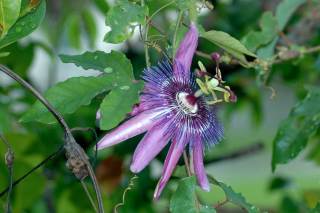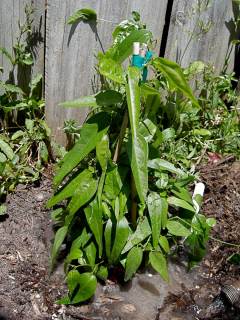One of the plants I scored at the native plant auction earlier this week is a real workhorse in the garden: Passiflora suberosa, Corkystem passionvine. It’s one of our two native passionvines. Not as showy as its cousin, P. incarnata (the “maypop” vine), it is nonetheless also a larval food plant for three species of butterfly in Florida: Gulf fritillary, Julia heliconian, and Zebra heliconian. I’ve had several generations of Gulf fritillaries on the maypop at the old house; I’m hoping for many more to come on the corkystem here at the new digs…
Here’s what the maypop looked like at my house in 2009:
Here’s what the corkystem flower will look like (from the NABA information page about this vine):
Quite a difference, eh?
And here is what it looks like in my yard at the moment:
Unassuming, to be sure, but with loads of wildlife potential. According to the write-up in Coastal Dune Plants (the first of a 5-volume series of booklets detailing over 200 common plants in the ecosystems of South Florida; the other volumes are Coastal Hammock, Scrub, Flatwoods, and Wetlands),
Birds are fond of these fruits and are the main dispersers of the seeds, “planting” them in their droppings. Another animal relationship is with the zebra butterfly. This local representative of the tropical family Heliconidae lays its eggs only on passionflowers, the caterpillars feeding on them specifically. The plant has developed defenses against this onslaught, including poisons in the foliage and even the growing of “fake eggs” on the stem. If a female butterfly sees these, she will move on without laying her own eggs.
Quite a story, eh? I’ve not seen any fake eggs on mine (that I’m aware of), but I’ll keep looking!
I got another vine as well, a Jacquemontia, about which more later…




I’ve been trying to identify a type of passionflower that I’ve seen only in two different places. This type I’m looking for has a single lobe on every leaf unlike most that have three. It has a flower similar to the second picture, lighter in color and smaller than incarnata’s. It also leaves behind tiny little cucumber looking fruit (or a watermelon based on your opinion). The fruit is less than an inch in length and tastes neutral. I’ve haven’t consumed any because I know that most passiflora’s contain cyanide to some degree depending on species. If you can think of any single lobe leaved passiflori that bear small cucumber fruit would you please let me know of any? I can provide some pics if you like, but they are not flowering right now so I can show you the vine and flower at least. Any help is very appreciated!
Hi, Robert.
Passiflora suberosa have single-lobed leaves; that’s the only one I’m familiar with in Florida that does. And, of course, before the flowers open, they look like little teeny fruit. But I’m sure that’s not what you’re talking about.
Wunderlin and Hansen list several other Passiflora species for Florida, but they don’t talk about leaf shape for all of them, unfortunately. The one they do list as single-lobed in their identification key is P. coccinea, Scarlet passionflower. Listed from Pinellas and Hillsborough counties, native to S. America, escaped from cultivation.
What color are the flowers on yours? Any chance of a picture?
Ben, thanks again. From somewhere on these pages, I have gleaned the reason why my passion vine is acting so spoilt and leafy – it’s probably getting too much of that good thing called manure!
hello!
I’m hoping you can help me identify a passionflower that was given as a pass-along from someone who knows nothing about flowers! I live in Vero Beach and the plant has 5 lobed palmate leaves.
I haven’t uploaded it to my blog yet (want the identification first)but I did put it on Facebook in an album marked for public access. Would you mind terribly taking a look and seeing if you can identify the variety? here’s the url for you to copy and paste:
https://www.facebook.com/media/set/?set=a.404310329607978.85584.100000870432815&type=1&l=4cb239421b
Hi, Karen.
The plant in your picture looks very much like the hybrid strain of Passiflora incarnata x Passiflora cincinnata that is widely available in the nursery trade. It’s the same plant I have.
Here’s a description from a plant grower:
http://www.woodlanders.net/index.cfm?fuseaction=plants.plantDetail&plant_id=1267
It’s sometimes hard to find the “true” native! I’ve discovered that this vine is pretty aggressive, sending up young suckers quite far from the parent plant. Which is a good thing, because my backyard neighbor has some very aggressive clippers that seem to stray to my side of the fence fairly frequently.
Cheers!
Hello,Everyone
I have recently purchased a Passiflora Edulis but don’t know if it’s a host plant of any butterflies above mentioned and I would like to find out Do anyone knows? I have Dutchman pipevine for Gold Rim Swallowtails and milkweed for monarch very suscefull so far.
Thanks.
I don’t know about this particular vine but I imagine that it would be a host to the heliconians. Same genus. But I have not been able to verify this myself, so…